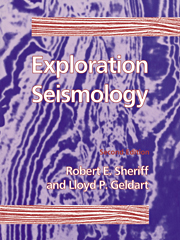Book contents
- Frontmatter
- Contents
- Preface
- Mathematical conventions and symbols
- 1 Introduction
- 2 Theory of seismic waves
- 3 Partitioning at an interface
- 4 Geometry of seismic waves
- 5 Seismic velocity
- 6 Characteristics of seismic events
- 7 Equipment
- 8 Reflection field methods
- 9 Data Processing
- 10 Geologic interpretation of reflection data
- 11 Refraction methods
- 12 3-D Methods
- 13 Specialized techniques
- 14 Specialized applications
- 15 Background mathematics
- Appendices
- Index
3 - Partitioning at an interface
Published online by Cambridge University Press: 05 June 2012
- Frontmatter
- Contents
- Preface
- Mathematical conventions and symbols
- 1 Introduction
- 2 Theory of seismic waves
- 3 Partitioning at an interface
- 4 Geometry of seismic waves
- 5 Seismic velocity
- 6 Characteristics of seismic events
- 7 Equipment
- 8 Reflection field methods
- 9 Data Processing
- 10 Geologic interpretation of reflection data
- 11 Refraction methods
- 12 3-D Methods
- 13 Specialized techniques
- 14 Specialized applications
- 15 Background mathematics
- Appendices
- Index
Summary
Overview
The partitioning of energy at interfaces is the central phenomenon of seismic exploration. Boundary conditions permit calculating how wave energy is divided among reflected and transmitted waves. The most easily understood approach, in terms of displacements, yields Zoeppritz' equations, and the calculation in terms of potentials yields Knott's equations. Both approaches are given here, even though they accomplish the same purpose, because of the importance of partitioning.
For the simple but important case of normal incidence (§3.2), which is commonly assumed in most reflection work, Zoeppritz' (or Knott's) equations reduce to the familiar equation for the normal reflection coefficient. This equation states that the reflection amplitude, compared with the incident amplitude, varies directly as the change in acoustic impedance (the product of velocity and density). Examples of reflection coefficient magnitudes are given.
Reflection at nonnormal incidence (§3.3) leads to wave conversion and amplitude changes, especially near the critical angle. The Zoeppritz equations, while exact, do not give a feeling for how amplitudes depend on the various factors involved. Several approximations have been made in an effort to achieve an equation form that gives more insight into the changes expected for various situations. In particular, the variation of amplitudes with angle (§3.4), more commonly expressed as amplitude variation with offset (AVO), has become important in the last few years as an indicator of hydrocarbon gas.
Refraction methods are usually based on a simple head-wave concept (§3.5) (although the waves involved are, in fact, much more complex); the simple concept yields correct traveltimes and provides a basis for the interpretation of head-wave traveltimes.
- Type
- Chapter
- Information
- Exploration Seismology , pp. 73 - 84Publisher: Cambridge University PressPrint publication year: 1995



